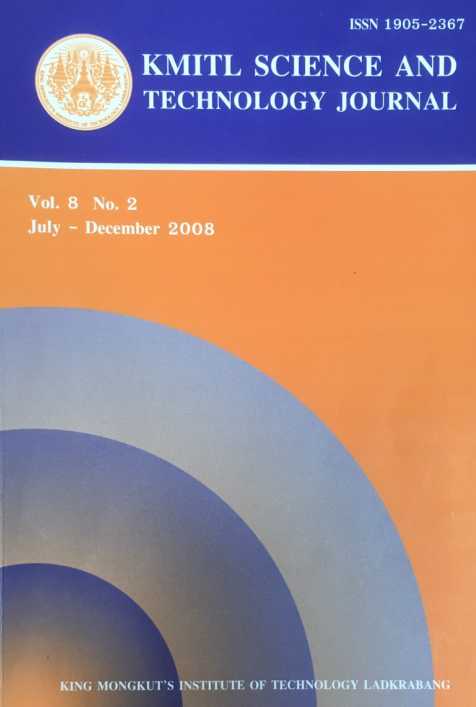Application of Non-Thermal Processing for Preservation of Orange Juice
Main Article Content
Abstract
The application of non-thermal processing for inactivation of yeast (Saccharomyces cerevisiae) in orange juice was investigated and compared with conventional thermal processing. The results showed that less than 1 log of yeast in orange juice could be inactivated during thermal processing at 50 0C and 15 min treated time. In contrast high pressure treatment at moderate temperature (50°C) and 100 to 300 MPa resulted in total (up to 6 log ) inactivation of yeast in orange juice. Supercritical CO2/liquid CO2 treatment at ≥6 MPa and 50 °C was sufficient to inactive yeast up to 6 log after 15 min treatment time. For high electric field pulses, the field strength used in this study(15 kV/cm) was high enough to reduce the yeast number up to 2 log after 60 pulses in orange juice.Inactivation of yeast in orange juice using ultrasound is possible. Ultrasound amplitude at ≥40%(≥80 W) combined with moderate temperature (50 0C) resulted in up to 6 log inactivation of yeast in orange juice after 15 min treatment.
KEYWORDS: non-thermal processing, orange juice, yeast inactivation, ultrasound
E-mail: egmne@mahidol.ac.th
Article Details
Copyright Transfer Statement
The copyright of this article is transferred to Current Applied Science and Technology journal with effect if and when the article is accepted for publication. The copyright transfer covers the exclusive right to reproduce and distribute the article, including reprints, translations, photographic reproductions, electronic form (offline, online) or any other reproductions of similar nature.
The author warrants that this contribution is original and that he/she has full power to make this grant. The author signs for and accepts responsibility for releasing this material on behalf of any and all co-authors.
Here is the link for download: Copyright transfer form.pdf
References
[2] Arnsson. K., Lindgren, M., Johansson, B. R. and Ronner, U. 2001 Inactivation of microorganisms using pulsed electric fields: the influence of process parameters on Escherichia coli, Listeria innocua, Leuconostoc mesenteroides and Saccharomyces cerevisiae, Innovative Food Science & Emerging Technologies, 2, 41–54.
[3] Sale, A. J. H. and Hamilton, W. A. 1968 Effect of high electric fields on microorganisms III. Lysis of erythrocytes and protoplasts, Bioghim Biophys Acta 163, 37–43.
[4] Raso, J. and Heinz, V. 2006 Pulsed Electric Fields Technology for the Food Industry. Springer.
[5] Hoover, D. G., Metrick. C., Papineau, A. M. Farkas, D. F. and Knorr, D. 1989 Biological effects of high hydrostatic pressure on food microorganism. Food Technology, 43(3), 99–107.
[6] Morita, R. Y. 1975. Psychrophilic Bacteria, Bacteriological Review, 39, 144–167.
[7] Ballestra, P., Silva, A. A. D.and Cuq, J. L. 1996. Inactivation of Escherichia coil by carbon dioxide under pressure, Journal of Food Science, 61, 829–836.
[8] Erkmen, O. 1997. Antimicrobial effect of pressurized carbon dioxide on Staphylococcus aureus in broth and milk, Lebensm. Wiss. u. Technology, 30, 826–829.
[9] Hass, G. J., Prescott, H. E., Dudley, E., Dik, R., Hintlian, C. and Keane, L. 1989. Inactivation of microorganisms by carbon dioxide under pressure, Journal of Food Safety, 9, 253.
[10] Kamihira, M., Taniguchi, M. and Koybsyashi, T. 1987. Sterilization of microorganisms with supercritical carbon dioxide, Agricultural Biological Chemistry, 2, 407.
[11] Truong, J. M., Boff, D. B. and Shellhamer, T. H. 2002. Effects of carbon dioxide in highpressure processing on pectin methylesterase in single strength orange juice., Journal of Food Science 67 (8), 3058–3062.
[12] Tedjo, W., Eshtiaghi, M. N. and Knorr, D. 2000. Impact of supercritical carbon dioxide and high pressure on lipoxygenase and peroxidase activity, Journal of Food Science, 65 (8), 1284–1287.
[13] Suslik, K. S. 1988. Ultrasounds: its Chemical, Physical and Biological Effects, New York,VHC Publishers.
[14] Lillard, H. S. 1994. Decontamination of poultry skin by sonication, Food Technology, 48, 72–73.
[15] Sala, F.J., Burgos, J., Condón, S., López, P. and Raso, J. 1995. Effect of heat and ultrasound on microorganisms and enzymes. In New Methods of Food Preservation, pp. 176–204. G. W.Gould (ed.). Blackie Academic and Professional.
[16] Toepfel, S., Heinz, V. And Knorr, D. 2007. High intensity pulsed electric fields applied for food preservation, Chemical Engineering and Processing, 46, 537–546.
[17] Spilimbergo, S., Mantonan, D. and Dalser, A. 2007. Supercritical gases pasteurization of apple juice. Journal of Supercritical Fluids, 40, 485–489.
[18] Parton, T., Elvassore, N., Bertucco, A. and Bertoloni, G. 2007. High pressure CO2 inactivation of food: A multi-batch reactor system for inactivation kinetic determination, Journal of Supercritical Fluids, 40, 490–496.
[19] Chen, C. and Tseng, C-W. 1996. Effect of high hydrostatic pressure on the temperature dependence of Saccharomyces cerevisiae and Zygosaccharomyces rouxii. Process Biochemistry, 32 (4), 337–343.
[20] Raso J, Pagan R, Condón S, Sala J. F. 1998. Influence of the temperature and pressure on the lethality of ultrasound, Applied and Environmental Microbiology; 64, 465–471.
[21] Berliner, S. 1984. Application of ultrasonic processors, International Biotechnology Laboratory, 2, 42.
[22] Guerrero, S., López-Malo, A. and Alzamora, S. M. 2001. Effect of ultrasound on the survival of Saccharomyces cerevisiae: Influence of temperature, pH and amplitude, Innovative Food Science & Emerging Technologies, 2, 31–39.


